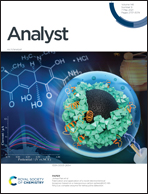A multimer-based SERS aptasensor for highly sensitive and homogeneous assay of carcinoembryonic antigens†
Abstract
Carcinoembryonic antigens (CEAs) are known as one of the most common tumor markers. Their facile and affordable detection is critical for early diagnosis of malignant tumors, especially in resource-constrained settings. Here, we report a novel multimer-based surface-enhanced Raman scattering (SERS) aptasensor for a specific CEA assay. The aptasensor is fabricated through aptamer-assisted self-assembly of silver-coated gold nanoparticles (Au@Ag NPs), and the self-assembled multimeric structure possesses abundant hot-spots to provide high SERS response. When CEA is introduced, the specific recognition of CEA by aptamers will lead to the disassembly of Au@Ag multimers due to the lack of a bridging aptamer between Au@Ag NPs. As a result, the number of hot-spots in the multimeric system is decreased, and the intensity at 1585 cm−1 of the SERS reporter (4-mercaptobenzoic acid, 4-MBA) on the surface of NPs will also be decreased. The Raman intensity is proportional to the logarithm of the concentration of CEA. The detection sensitivity can be down to the pg mL−1 level. The analytical method only needs a droplet of 2 μL of sample, and the detection time is less than 20 min. The multimer-based SERS aptasensor can be applied in sensitive and inexpensive detection of CEA in serum samples.



 Please wait while we load your content...
Please wait while we load your content...